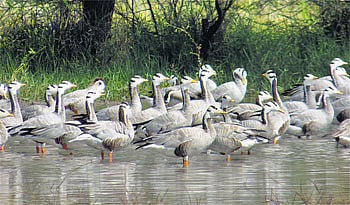
Come winter, bird lovers can witness a grand spectacle of thousands of Bar-headed Geese quacking, swimming, flying and nesting in Magadi Lake in Shirahatti taluk of Gadag district.
To escape the severe cold, these migratory birds migrate all the way from Mongolia, Tibet and Ladakh during winter season from November to February to South Asia and all the way to Magadi wetlands spread across 136 acres.
The lake is maintained by Karnataka State Forest Department.
3,500 birds
These migratory waterfowls have adapted to this environment very well. About 3,500 birds have arrived this year. These include at least 28 birds which are collared. Of these collared birds, two of them which were here on their previous visit, have been spotted. Last year 23 collared birds were noticed.
The red, yellow and green-collared birds carry numbers or words. These have been recorded by the Forest department guard Somanna, who has been assigned this work.
The Bar-headed Goose (Anser indicus) is a goose which breeds in Central Asia in colonies of thousands near mountain lakes and in winters in South Asia.
They reach as far south as peninsular India. It lays three to eight eggs at a time in a ground nest. The Bar-headed Goose is thought to be one of the world's highest flying birds, flying over Mount Everest migrating to many parts of India including Magadi lake. By March-April these birds return to their original habitation.
The Ministry of Environment and Forests has recognised the significance of Magadi wetlands and has given high priority for conservation and protection of the site for the birds’ migration and breeding. There is also a three storey watch tower built for bird watching with a forest official manning a field scope.
“The other birds found in Magadi lake include brahmini ducks, grey herons, comb ducks, Eurasian spoonbills, purple herons and painted storks which arrive here to nest on its banks between November and February every year, providing a feast for bird lovers,” said Sommana.
Farmers’ largesse
At dawn and dusk the birds visit the fields around the lake to feed on groundnuts, gram, wheat and rice. However, the farmers do not consider these birds as pests, add Somanna.
“In South India the maximum number of birds come here for nesting thanks to the protection given by the Forest department and the magnanimity of the farmers,” says
Gurunath Desai, Secretary of Hubli-based North Karnataka Birders Network (NKBN), which keeps a track of birds in the geographical range which includes whole of North Karnataka - Belgaum, Gadag, Haveri, Koppal, Bijapur, Bidar, Raichur, Gulbarga, Uttara Kannada and Dharwad districts.
